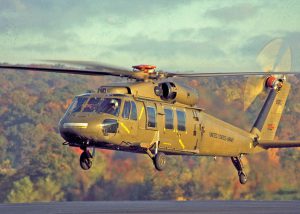
Sikorsky Takes the UTTAS Prize
The first flight of Sikorsky Aircraft’s Black Hawk occurred 50 years ago, on October 17, 1974. Since then, over 5000 Black Hawks have been delivered to customers, making it Sikorsky’s longest production program.
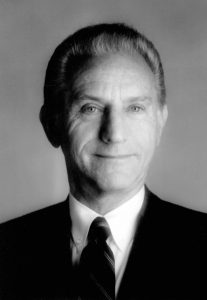
Working in the aviation industry never entered my mind when I was looking for a job several weeks before graduating as a mechanical engineer. None of my college courses had any specific relation to flying machines nor did any of my summer jobs. I never thought about helicopters but I do remember seeing a “Sikorsky” once. That’s how local people referred to helicopters. However, a Sikorsky Aircraft ad in my local newspaper looking for new engineering graduates caught my interest because their Bridgeport location would be within commuting distance from home. But I knew that getting a job there was a long shot because I didn’t know a single Sikorsky employee and I knew absolutely nothing about helicopters. Fortunately, Sikorsky’s need for warm bodies was so urgent that helicopter expertise was not essential to getting hired. Besides, back then there weren’t many people walking the streets who knew anything about helicopters. Since I needed a job, I decided to give Sikorsky a try regardless of the odds. That try at most would only cost a day plus a few gallons of gas.
After finding the Sikorsky plant, I parked alongside the flight field and looked at the many R-4s, S-51s and S-55 helicopters that mechanics were working on. They really seemed to be complicated machines. I thought how great it would be for a mechanical engineer to help design these mechanical monstrosities. From what I could see in the open cowlings and access panels, it appeared that all parts of the helicopter were meant to move relative to each other and there were so many parts. I later learned that a helicopter could be described as a collection of moving parts all flying in close formation. That was a pretty accurate description. Today we would include several million lines of software code flying alongside those parts and hopefully remaining in formation.
Beyond the potential satisfaction of working on such complex machines, I felt that joining a small company seemed to be a good first step, especially with a company whose founder was a recognized aviation pioneer. So with pumped up courage, I knocked on the guardhouse door to find out whom to talk to about a job. After several interviews that same day they offered me a junior engineering job at $298 a month with a start date one week after graduation. In retrospect I believe that day was one of the best and luckiest of my life. Plus my mother was so happy at the prospect of her son finally paying for his room and board.
At the time when I was hired, I did not know that Sikorsky Aircraft was a relatively infant helicopter company. It had only been 12 years since the first successful flight of the VS-300 made by Igor Sikorsky. I was impressed with how quickly following that first successful flight that they were able to produce hundreds of helicopters during World War II. Building the R-4 model at a rate of ten per month was a great achievement that many helicopter companies today would consider being good business.
I joined Sikorsky during the initial hiring of many new engineers. When I started work there were only 200 people in the engineering department. That number grew to 2500 when I retired 41 years later. In 1951 the company was starting to rebuild its staff and production capacity as a result of the war in Korea and the military’s need for more transport type helicopters. For Sikorsky that meant ramping up the S-55 and S-58 production lines eventually setting annual production records that peaked in 1957. During that year about 450 helicopters were delivered. And that record year remains unmatched even to this time. What makes that achievement even more remarkable is that Sikorsky, like most other aviation companies, was a vertically integrated company that built most of the helicopter’s component parts. Its input of raw material included forgings, castings, sheet metal, coils of wire and tubing, engines, fasteners of all types and much more. Out the hanger doors came a finished helicopter ready for flight acceptance.
I want to mention the key reason that led to those helicopter production records during the 1950s. It was a direct result of individual creativity. To quote Igor Sikorsky, “The spark of the individual moves mankind forward”. That spark saved the company with the invention of the unique configuration embodied in the S-55 and then the S-58 models. The prior R-4 model had its engine directly under the main rotor, which forced the passengers or payload to be located ahead of the rotor. Although that was acceptable for small observation type helicopters, it was a poor configuration for larger ones because the aircraft’s center of gravity moved far too much as payload was loaded or unloaded.
That critical flaw resulted in Sikorsky losing a major competition for US Navy search and rescue helicopters just after WW2. The winner was Piasecki with its tandem rotor configuration. Sikorsky had no orders and no prospects following that major loss. It absolutely needed a new design or major innovation. That breakthrough came when the S-55 was created in the late 1940s.
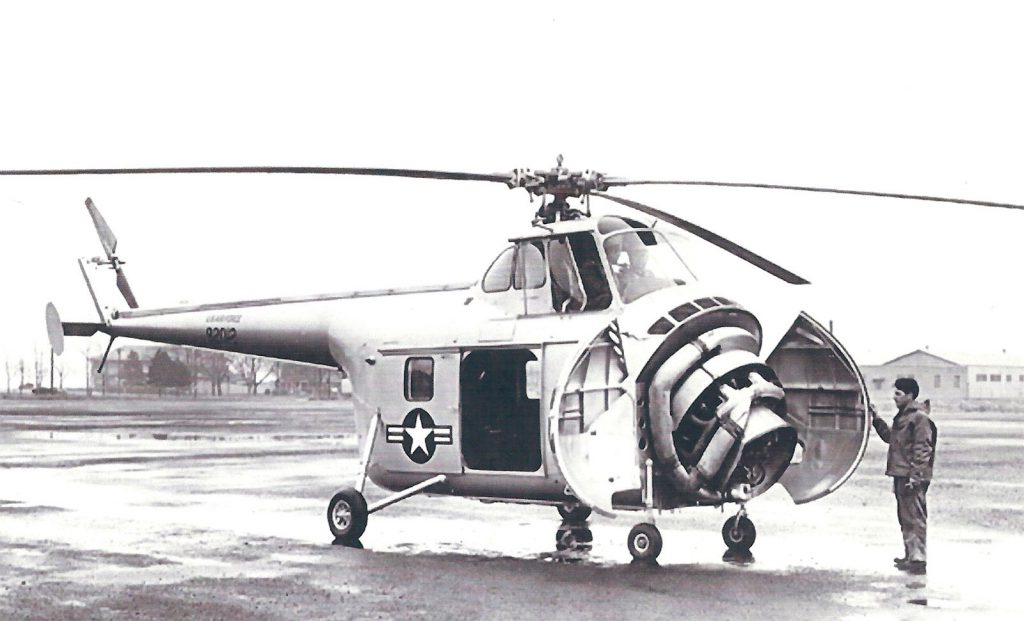
Edward Katzenberger, who was Chief of Advanced Design at that time, had the idea of moving the engine from directly below the rotor to the nose of the aircraft and locating the pilot above it. That “spark of the individual” allowed the fuselage volume directly under the rotor to become a cabin. The critically important result was that passenger/payload loading or unloading would have a small effect on CG movement. With that new configuration Sikorsky was able to compete with the tandem rotor design. After building the first S-55 in only seven months and demonstrating it extensively, orders poured into the company. Over1300 were built for the US military plus several hundred under foreign license. That model was followed by the larger S-58 with the same engine-forward configuration. Over 1800 were built for US operators plus 500 under foreign license.
I’ve seen that “spark of the individual” sparkle many times at Sikorsky along with the results that it produced. It is a healthy condition encouraged and nourished by management focus and appreciation of innovation. That appreciation of innovation was not always apparent during earlier periods however it is now the cornerstone of Sikorsky culture.
Let me tell you what Sikorsky was like when I was hired off the street 67 years ago. That timeframe is ancient history but to me its still seems like yesterday.
The predominant company focus during those early days was to make its helicopters work and to fly with some measure of reliability. During the decades of the 1940s and 1950s, Sikorsky engineers weren’t terribly concerned about high-speed performance, high vertical rate of climb, stomach-turning maneuverability or even high altitude performance as they are today. It was just making the basic helicopter function safely that was so important along with keeping vibrations down to a tolerable level.
I remember when the chairman of the United Aircraft Corporation, who was Leonard Horner, used to visit the various UAC sites in Connecticut using Sikorsky’s two-passenger S-51 helicopter. Sikorsky management was so concerned that Mr. Horner would be able to make that long flight from Hartford down to Bridgeport without having a transmission chip light come on, without losing oil pressure or without severe vibrations forcing him to land someplace along the way. Getting this complex machine to function reliably and safely was the major objective until engineers had time to work on performance improvements.
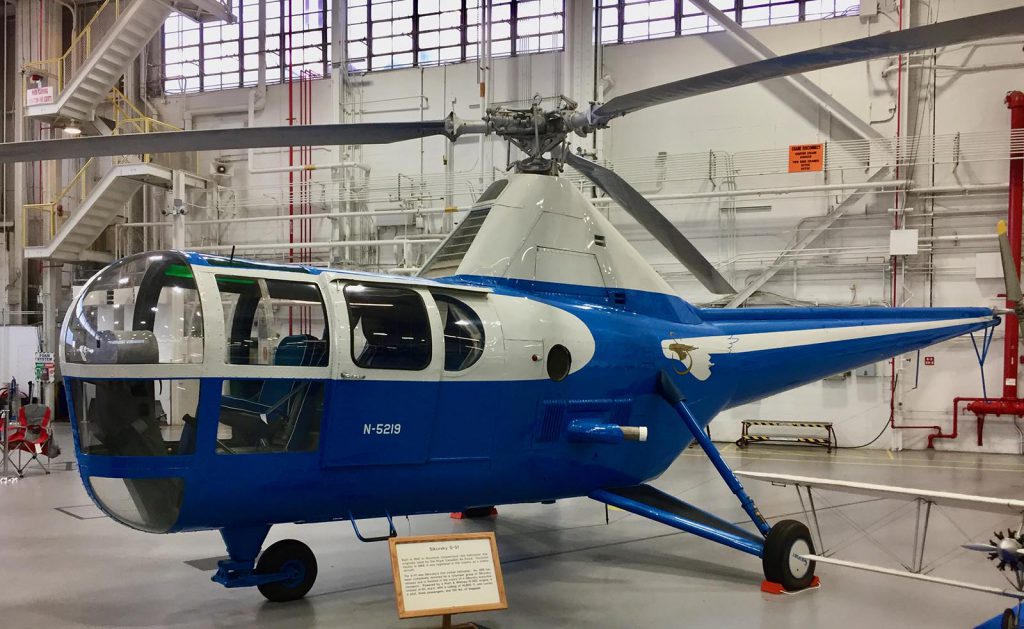
The people that I got to work with were quite extraordinary. About half of the engineering department consisted of Russian immigrants who left Russia at the time of the revolution. Many sought out Igor Sikorsky when he created his own company on Long Island. They were very motivated and dedicated people and very willing to help young guys like me who knew absolutely nothing about helicopters.
Mr. Sikorsky was a person with true passion about his creation. I think that his greatest interest was in their design. He used to walk around the drawing boards almost every day to look at what was being designed and talk to designers as his friends rather than his employees. He would always introduce himself and address people by their last name. He addressed me as Mr. Leoni, which left me speechless. Mr. Sikorsky seemed to be the most humble gentleman that I ever had the honor to know. There would be more opportunities for me to speak with him and to develop a lasting loyalty to his company and to its people.
What impressed me about the engineering department during my early employment was that there was very little documentation available to help learn about helicopter theory and design. There were no helicopter textbooks. There were no courses about helicopters in college and no company sponsored educational opportunities at that time. To make learning even harder, there were no design manuals, no lessons learned reports and in fact there were very few technical reports. But that began to change when a few engineers from Sikorsky and several other companies created the American Helicopter Society. That society over time generated a great deal of very useful technical information for engineers and designers and, of course, it still does but now on an international scale. I became a member of the AHS in 1952 and I still am a member who looks forward to its publications and meetings. The American Helicopter Society, recently renamed the Vertical Flight Society, has been an enormous help to me in learning and staying current in the vertical flight industry.
With respect to textbooks, I recall so clearly when in 1952 a new book written by Alfred Gessow and Garry C. Myers, Jr. entitled “Aerodynamics of the Helicopter” was published. It was like the Bible for newcomers to the helicopter field. Finally the theories that explained rotor blade motion and control as well as power required and sources of vibrations could be understood. That one book delivered me from a total state of ignorance to a state of partial understanding such that I could almost call myself a helicopter engineer, at least in private.
As a result of this dearth of helicopter reports or books, the main source of technical information was in peoples’ memories so you needed to extract information from their heads. But the problem was that their heads were not labeled. You never knew who to go to for help until the person with the needed expertise was finally pointed out. When you found that right expert, you would always find a person who was most willing to help the young guys. Many of those old timers lacked formal education but they were heavy on good intuition and hands-on experience. Many spoke English quite understandably but you could sense that they were thinking in Russian while talking to you in English as best they could.
I remember once when I was designing the rotor head for the new S-61 helicopter when I came across a problem in trying to size the lag hinge dampers. I went to my boss who could not help but suggested that I go see Michael Boivid. Michael Boivid was one of the immigrants who came to America and joined Mr. Sikorsky’s small company on Long Island in the 1940s. Michael was the key man who created every rotor head design up to that point in time. I went to see him, introduced myself, and asked him “How do you calculate the right diameter to use in designing the lag dampers?” Without knowing anything about the rotor that I was designing, he looked at me and said, “Three inches.” He added that all dampers for all our helicopters are three inches in diameter and they “work-ed verry good”. I have to say that if I were designing a rotor today, I would pick three inches for the dampers because they work-ed very good. That’s what Michael said.
They were interesting people, all of these early Russians. They all had fascinating stories about life in Russia, their escape out of Russia and their experiences in coming to America. I remember the story they talked about regarding the platinum prince. He was a member of the royal family in Russia who was trying to escape at the beginning of the Bolshevik Revolution. He was a very wealthy person looking for ways to smuggle part of his family wealth out of Russia. He had the clever idea of using the money that he made from selling family possessions in Russia to buy bars of pure platinum.
He took this platinum; I don’t know how much he had, but it must have been substantial and had the bars forged into mechanics open end wrenches. He took the beautiful wrenches and then beat them with a hammer to make them all look dented and well used. He then coated the wrenches with grease and dirt, put them in an old duffel bag, and walked carrying his heavy bag of dirty tools across the border out of Russia while the border guards scoffed at his dirty bag of dirty tools. He successfully found his way to America with his bag of platinum. I don’t know if he ever worked at Sikorsky although I do remember a former Prince that worked here whose first name was Sergei, and he seemed to have a good lifestyle. Maybe he was the platinum prince.

I recall one day being in Professor Sikorsky’s office asking him for help in calculating rotor performance. Prof Sikorsky, as he was called, was Igor Sikorsky’s cousin who had become the company chief aerodynamicist. When I sat down next to his desk, I noticed that his extra long slide rule was full of burn marks because he oftenrested his burning cigarette on the slide rule while doing something else. I asked Prof what would he do if the cursor ended up directly over a burn mark obscuring the answer to his string of calculations. Without hesitating, Prof replied “I make-ed very good guess”. I wondered how many performance guarantees to our customers came out of Prof’s “verry good guesses”. Prof was truly a godsend for aerodynamic know-nothings like myself. He taught me so much about calculating performance using a slide rule and his equations along with his tip loss factors and other special modifiers that he created.
As far as our work in those days, I do remember it being very, very time consuming. Everything that we did we did by hand whether it was designing, calculating or writing. All we had were slide rules, no computer programs or any kind of automated processes. Since we had a small engineering department at that time, many people had to become proficient at a variety of design disciplines. Today you worked on a new rotor design or a new landing gear; tomorrow it could be a new gearbox design. Helicopters have always had a predilection for gearing and each gear mesh needed to be drawn at large scale to be certain that the teeth engaged properly. That meant creating the involute profiles of the teeth on the drawing board using only common drafting tools: compass, straightedge, rulers, and trusty trig tables. From the resulting large-scale layouts, the need for modifying the tooth tip and root shapes to avoid interference could be determined and forwarded to the gear manufacturer.

Even the process of making drawings was very time consuming. I remember starting my drafting career when everyone drew with pencil on vellum paper. Some years later we changed from pencil to ink on Mylar and thought that was fantastic until you needed to make changes to the inked design. Today all of that tedious drafting work is done using computer-aided design (CAD). CAD led not only to much greater engineering productivity but also to much better accuracy plus the ability to have remote design teams work together.
Today the engineering design process is based on the computer and built-in rules help to avoid errors that were so common in prior generations. I believe that the design process technology has advanced almost as much as the technology of the product. Now when you see what engineering can do with CAD, the improvement in productivity for engineering has been quite dramatic. That means that engineers have an opportunity to be far more innovative. It frees up time to do creative work rather than normal gut work. You can do that work now with so much more accuracy than you could before, with automatic dimensional checking, virtual mock-ups and 3D computer mock-ups. One would hope that the work we do today would be far more error free than what we did before. Engineering design errors have always been a cause of problems, particularly for the factory as well as for the operator.
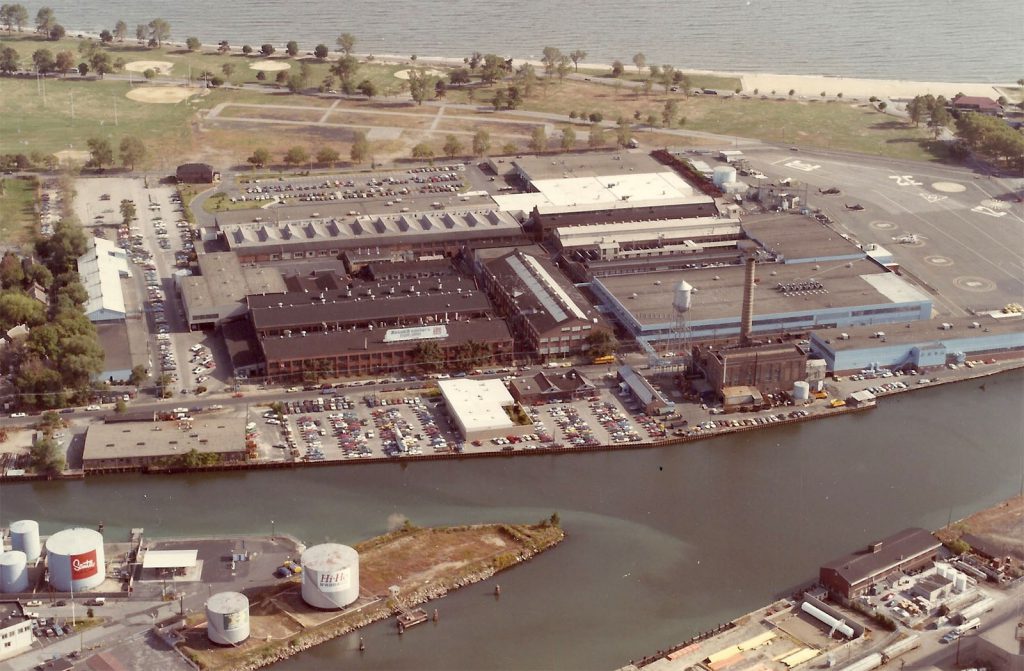
When I started work in Bridgeport, the engineering department basically was squeezed into one big room on the second floor of the administrative building. There were some offices on the periphery, but basically we were all together out in the open. There was no room for little cubicle offices.
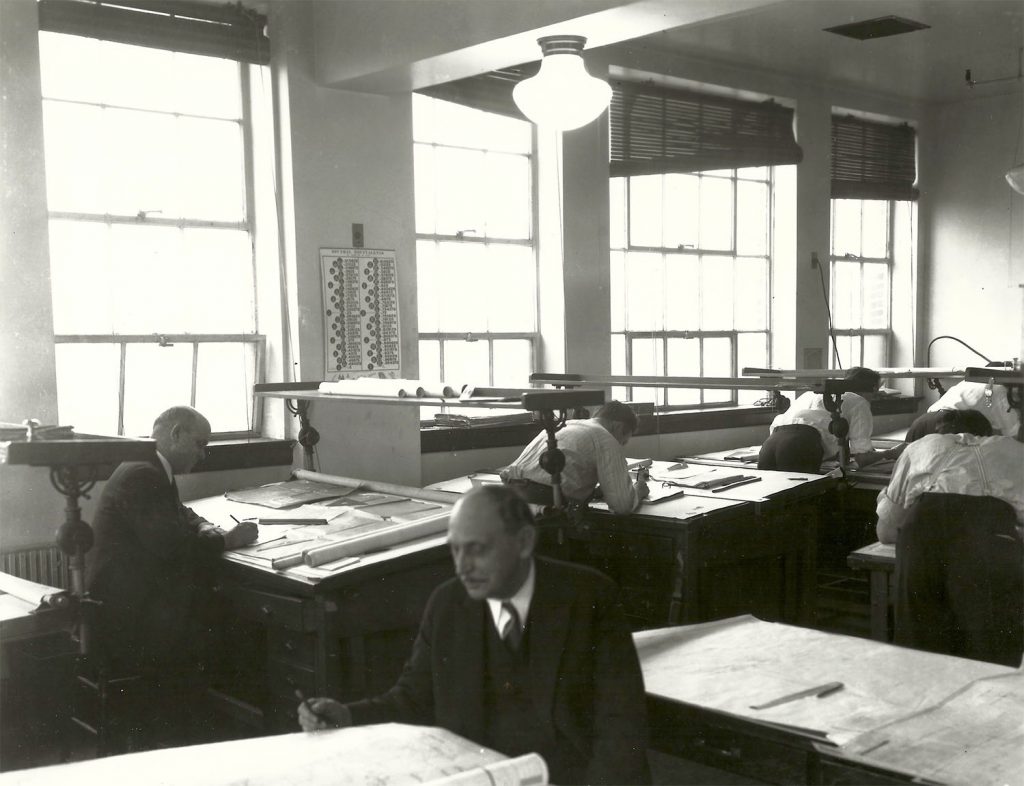
Being seated out in the open made it easy to see guests coming in to visit with Sikorsky senior management people. On several occasions we saw Charles Lindbergh walk down the aisle to visit with Mr. Sikorsky and his chief engineer, Michael Gluharef. I’m sure that everyone who saw Lindbergh felt a thrill. When I got home and told my wife who I saw that day she informed me that she was related to Lindbergh’s wife, Ann Morrow Lindbergh. I had wondered how my wife, Patricia, acquired her middle name “Morrow”. So much for bragging about my people sightings at work!
Physical space got to be a pressing problem as engineers got hired. It finally became so crowded on the second floor that they opened up the third floor loft of the Bridgeport building that had been a storage area along with the blue printing machines. I was one of those people who were moved up there with a drawing board and all my drafting tools. I will always remember that place. We didn’t have air conditioning so we kept all the skylights open. As a result birds used to fly in and sit on the rafters. They were mostly seagulls as we were very near the water. The birds would perch up on the rafters and do droppings right on our drawings. It was tough with the vellum to clean them off. Mylar was a little easier to clean but seagulls left big reminders of their presence. The intense ammonia smell of the blueprint machines helped to offset the smell of the seagulls. The third floor could be described as the engineering purgatory. Every time I go into a Home Depot store and see birds flying around I’m reminded of that third floor in Bridgeport.
The engineering team was really bunched all together. Groups of four desks were placed together with each desk contacting two other desks. One telephone serviced each group of four desks. At first it was a status symbol to have a telephone on your desk until you realized that three other guys shared that phone with you and you had to answer all calls to them.
The same thing happened when mechanical calculators became available. They were a godsend at first. Management decided to buy these huge Frieden and Marchand mechanical calculators, the size of typewriters that took up a lot of desk space and were extremely noisy. Initially those monstrosities were thought to be another status symbol like the telephone until you found that people would come over and start making all that noise right on your desk. Electronic calculators were a blessing when they arrived years later and became part of personal property.
I believe that the telephone system in the Bridgeport plant was designed to discourage people from communicating with each other. The company relied on its public address system to connect people together on the telephone. In order to connect with people you wanted to talk to, you paged them over the public address system. When hearing their name they would pick up any phone that they happened to be near and dial the operator who would make the connection to your caller. There happened to be a fellow, who became a good friend of mine because of this antiquated paging system. His name was Ray Maloney. You can imagine what happened when Ray Maloney was paged and Ray Leoni answered and vice versa. We would most often pick up each other’s call. That’s how I got to know him and many other people.
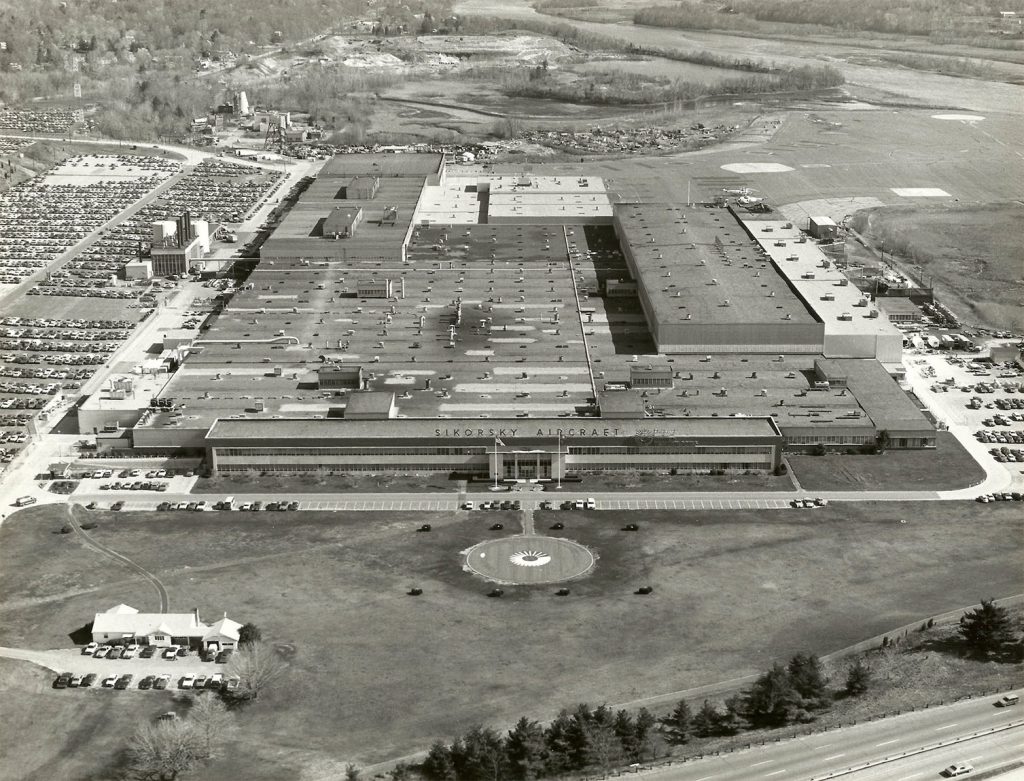
As the engineering population grew, working conditions in the old Bridgeport plant became quite substandard, especially for those of us stuffed into the third floor. What kept us going was the knowledge that soon we would be moving to the new facilities being built in Stratford that would be ready to occupy in the late 1950s. We really hoped that the new building would provide a more humane working environment. To our good fortune and as promised by management, the Stratford facilities turned out to be incredibly better than Bridgeport in every respect for all engineering personnel. And, to their displeasure, birds were not permitted entrance.
One of my early jobs was to be a data recorder for the tie-down testing of the new S-55 at the time before automated data recording and analysis was invented. The Government’s qualification process called for running the helicopter for 200 hours through a spectrum of power levels while tied to the ground. Being the new kid on the block, I was awarded the really coveted assignment of working the night shift of this test program. I remember sitting in that little shack in a corner of the Bridgeport South Avenue flight field with the S-55 anchored to the ground right in front of the shack. A crew chief and mechanic sitting in the cockpit operated the controls to adjust engine power as prescribed while the engine and rotors would drone throughout the night. My job was to read all the gauges that displayed the temperature and pressure of the gearboxes, oil coolers, engines and every few minutes I’d have to write them all down. I’d have to periodically go outside with my sling psychrometer to sling it around in order to measure the humidity and write it all down. I often wondered, why I had to do this and who is ever going to read these reams of data? But of course, my bosses wanted to have trend data in case something went wrong. I remember driving home at night thinking, “My God, what a boring job I have.” On the other hand, I thanked God that nothing bad happened during my shift. But that unpleasant assignment was part of the learning process and I still felt lucky to have a job.
My most fortunate early assignment was to work for the company’s bearing expert who selected anti-friction bearings for all applications in the helicopter. He got me started as his helper in calculating loads applied to bearings and then he taught me how to select the right size and type of bearing. That was a fortunate assignment because I had to learn how helicopter mechanical systems worked. That included rotor heads, transmissions, flight controls and any place on a helicopter that used bearings. There are many such places in mechanical monstrosities.
From that experience I became interested in rotor head design. All Sikorsky production main rotor heads up to that time were of the fully articulated configuration. I had the idea of relocating the blade pitch change components from outboard of the coincident lag and flap axes to a position inboard of them. I called that design the “In-board Feathering Rotor Head”. Our chief engineer at the time could not get enthused about my creation because it was so different from past successful rotor heads. I got the impression that he considered design innovations to be a threat. Because of his predilection to hold on to past designs that worked, my new design never got built. But it was unique and had the potential of significant weight and parts reduction. Because of that potential, the company patented the design and put in on the shelf.
When Mr. Sikorsky was told about my design, he came over to my drawing board to see what it was all about. As he did before, he introduced himself and again addressed me as Mr. Leoni. He seemed to be very impressed with my design; at least he seemed to be. He said in such a nice way: “Mr. Leoni, this is very ingenious but if we only modified this small part of your design, if we only changed this part, and perhaps this other part that would make it even better”. I ended up changing much of the design, but he made me feel like his changes were of my creation and not his. He was without question a remarkable human being and an unforgettable person.
I remember an event that really demonstrated his humility. He came in one day from his home in Trunbull, walked into the front lobby of the administration building in Bridgeport whereupon the guard stopped him. He said, “Mr. Sikorsky, let me give you a temporary badge that you can wear.” Mr. Sikorsky didn’t know what he was talking about, but then realized he forgot to bring his badge to work. The guard said, “I’ll just give you a temporary one and just drop it off here when you leave.” Mr. Sikorsky’s reply was “No, no thank you.”
He walked back down the stairs, back to the parking lot, drove all the way back to Trumbull, got his badge and came into work. That story spread so quickly and left an impression on everyone who heard it.
He was also a courageous person without too much regard for his personal safety. We all remember the photographs of him flying in his first helicopter with his fedora hat and the white sneakers, no safety belt nor helmet.
One day we were going to fly the S-60 flying crane with a platform under its fuselage. Mr. Sikorsky had the idea that maybe the customer’s cargo would fit into standard containers, which could be carried on a platform beneath the helicopter. The day we were to fly this suspended platform, he was out on the flying field standing there watching when he turned to a mechanic and asked, “would you kindly get me a chair to sit on?” The mechanic promptly ran into one of the pilots’ office, came out with a folding chair and set it down at the hangar door for Mr. Sikorsky who exclaimed, “No, no, please bring it over to the helicopter.” He unfolded the chair next to the platform, climbed up and then managed to get on the platform. He then reached down, picked the chair up, put it in the middle of the platform and sat down.
The horrified pilot got out of the cockpit and shouted above the drone of the engines, “Mr. Sikorsky what are you doing?” He said he wanted to be on the platform to see if the vibrations from the rotor and its down wash would be acceptable. Here he was, sitting in the middle of the platform on a folding chair with no helmet and no seat belt. The pilot gingerly took off and flew very slowly around the flight field. They were so glad that Mr. Sikorsky didn’t slide off or get blown off. It was really a crazy thing to do but probably no crazier than flying his VS-300.
The last time that I talked with Mr. Sikorsky was in April of 1972 during his request to learn about the early Black Hawk. At that time we had just submitted our proposal for the UTTAS, which was the acronym for Utility Tactical Transport Aircraft System. Years later this name was changed to Black Hawk by the Army. We had constructed a full-size mockup made out of wood that we used during briefings to Army people during the proposal phase. Mr. Sikorsky wanted to see the mockup, as he had not been involved with the UTTAS design. His secretary called the program office to ask if it would be OK for Mr. Sikorsky to see the mockup and could someone escort him to the secure room in which it was located. I was asked to be that someone.
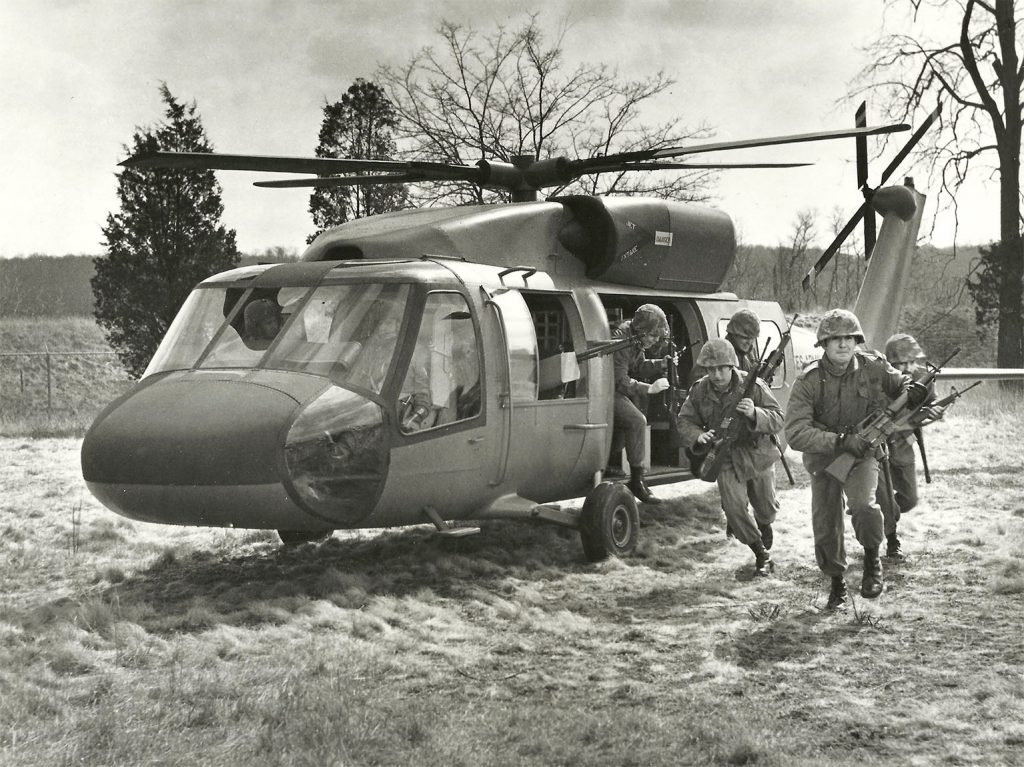
After walking into and around the mockup, Mr. Sikorsky was very complimentary and he appeared to be very impressed with the new design features of our UTTAS configuration. He always would give that impression anyway as he was just incapable of criticism. He was very interested in the design innovations that were incorporated because they were so different than the designs he had pioneered and embodied in his early models.
But he did ask me why the main rotor was so close to the top of the fuselage. I explained the need for a compact airframe to meet air transport requirements. The Army specified that the UTTAS must fit inside C-130 and C-141 cargo planes without removing the main rotor. Mr. Sikorsky understood the explanation but he clearly felt uneasy about the main rotor location. He had at that moment pointed out what proved to be a major flaw in our initial UTTAS design that was later corrected by raising the rotor 15 inches. His intuition was right on.
After I escorted him back to his office I stopped to see Catherine his secretary. I asked her: “Catherine, do you think it would be possible for Mr. Sikorsky to autograph a photograph of himself for me?” She replied, “Yes of course Mr. Leoni.” Time went by and I heard nothing from her. About a month later I got a call from Catherine who said, “Come up and pick up your photograph.” I came right over to her office and was given a very nice picture autographed by Mr. Sikorsky dated May 5th 1972. I said to Catherine: “What a remarkable coincidence. He signed it on my birthday!” She replied: “Well, he asked me to call the Personnel Department to find out when your birthday was going to be because Mr. Sikorsky wanted that to be the date of his signing.
I feel especially fortunate to have been able to interact on many occasions with Igor Sikorsky. He left such a strong impression on me that influenced my work choices in later years and even during my retirement. Later in my career I found it impossible to even consider employment offered by companies who competed with Sikorsky Aircraft. That loyalty included turning down consulting opportunities during retirement because I felt that helping competitors would violate a bond with Mr. Sikorsky. This clearly was a one-sided bond but never the less it was felt deeply by me. Perhaps its origin became clearer in my recollections.
Igor Sikorsky passed away just five months later in October 1972. Unfortunately he did not live to see the UTTAS fly and go on to become the cornerstone of our production revival. I’m so proud to have been a part of his lengthening shadow and so grateful to have the opportunity to work in the field of helicopters that continue to save lives and relieve human suffering around the world. It’s been a wonderful and memorable career. I’m thankful that I knocked on Sikorsky’s door 67 years ago looking for a job and so fortunate to have been hired. I had the opportunity to know a true aviation pioneer as well as the opportunity to help improve his creation.

The first flight of Sikorsky Aircraft’s Black Hawk occurred 50 years ago, on October 17, 1974. Since then, over 5000 Black Hawks have been delivered to customers, making it Sikorsky’s longest production program.
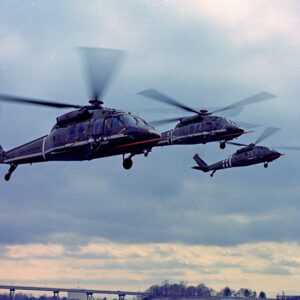
Former Sikorsky President Bill Paul reflects on his career with Sikorsky, meeting Igor Sikorsky, and the Sikorsky Aircraft Company’s 100th anniversary.
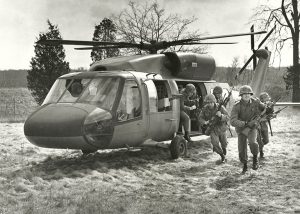
Ray Leoni recollects his 41-year career at Sikorsky Aircraft, beginning as a junior engineer and retiring as a Senior VP of Engineering and Advanced Programs.
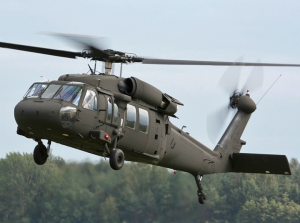
Late in the afternoon on December 23, 1976, Sikorsky received a telephone call that will likely rank as the most important call in its 90 year history.